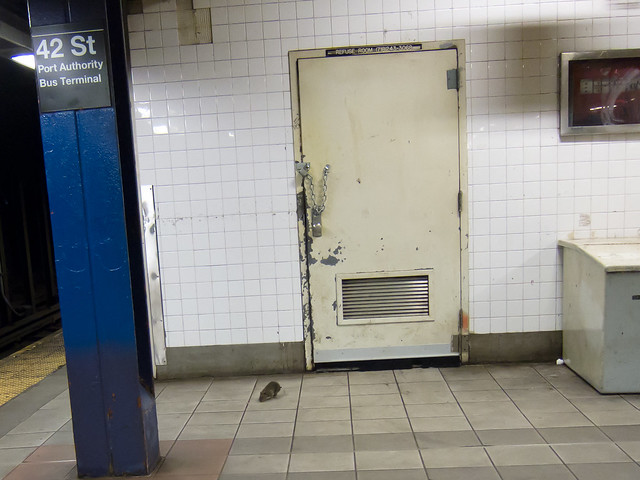
A rat awaits an A, C or E train at 42nd St. and 8th Ave. (Photo by flickr user Susan NYC)
Much like the rodents themselves, stories about the MTA’s attempts to contain its rat problem never really go away. The MTA knows it has to eliminate garbage to eliminate rats, but the budget doesn’t allow for refuse collection frequent enough to keep the animals out. A pilot to remove garbage cans has been mildly successful, but as long as subway riders chuck food into the tracks, the rats will never leave.
The oft-discussed, never-implemented idea to enact a total ban on food in the subways never gets anywhere due to its controversial nature, but that’s one solution that could limit the rat problem. Still, rats are horny little buggers. The animals reach sexual maturity in about five weeks and produce litters of seven to 14 four times a year. With a gestation period of 21 days, that rat population can explode quickly.
So what if the MTA could control the rat population’s birth rate? Maybe the city could contain its rat problem through science. That, at least according to the latest from Ted Mann, is how the MTA is now approaching its rat problem. The Journal reporter offers up this tidbit on rat birth control:
Working with SenesTech Inc., the Metropolitan Transportation Authority is launching the first urban trial of a pest-control bait that induces permanent infertility in rats. The product has succeeded in rural environments, lowering rodent populations without harming other animals, crops or humans. In New York, however, the company faces a new and vexing challenge: Big-city rodents have developed more sophisticated palates than their country counterparts, who have been lured into switching from grains or other foods to the bait…
But winning over rattus Norvegicus, the species common to New York, means making bait that’s more alluring than the pizza crusts, discarded Chinese takeout and cold French fries littering the subway system. It is a difficulty the company acknowledged in a grant application to the National Institutes of Health, which has put up more than $1 million to finance tests of its sterilizing product, ContraPest, in a metropolitan setting. Existing baits, the company wrote, are hampered in cities by “the abundance of more palatable food choices (i.e. trash).”
Later this month, Dr. Mayer and her colleagues will launch a rodent taste test in a handful of subway trash rooms. The scientists will spread birth-control bait of different flavors and scents. Should other available food scraps prove too tantalizing, Dr. Mayer didn’t rule out resorting to using pieces of pepperoni. “We really won’t know [what works] until we get in there,” she said.
Mann’s article delves into the technicalities behind these efforts. The idea is to introduce menopause earlier in rats so they have fewer opportunities to procreate. As Mann writes, the poison has to outpace procreation, but slowing down procreation could help too.
At this point, it’s worth exploring any avenue in the fight against rats. They’re large, gross and agressive, and they lend an air of anarchy to the subway system. They seemingly symbolize an endless fight against a clean, sanitary environment and add to the overall dinginess of many parts of the system. Short of aggressively eliminating all food underground, there’s only so much we can do to cut down on rats.

16 comments
Once again demonstrating the failure of “abstinence only” education.
Reminds me of that movie “Mimic”.
Now that you’ve mentioned it, it does sound a lot like Mimmic. If things hold true to form, we’re going to have giant humanoid rats in about three years. LOL
We already do. They run NJ Transit.
Well, it’s time that happened.
Uuuum simple solution, ban food & drink!!! the humans are the pigs! it’s common sense but oh wait we’re dealing w/ the MTA so oh well…ugh and who whould want to eat in the subway in the first place, it smells!
Even simpler: Get rid of trash cans in all NYCT stations!
Banning food won’t work any better than making littering illegal. Certain New Yorkers, we all know the types, are disgusting pigs and will drop their trash wherever they want. They also spit on the floor of the train between their legs. These people need to be arrested and clean up stations the way drunk drives clean up ditches.
Of course, that would require frequent police supervision, so forget it.
Solution: Platform screen doors, articulated trains, and not a lot of trash cans.
I don’t get it. If we’re luring rats to eat some kind of poison, why not make said poison simply kill them instead of sterilizing them? A dead rat can’t reproduce, either.
The TA doesn’t want to have to deal with dead rat bodies.
Untrue. The poison is contingent upon rats eating it before they reproduce. As often as the MTA baits the subway tracks — which is fairly often — rats can reproduce within five weeks of birth, and there’s no guarantee they’ll die before then from poison.
No, I was referring to the effects of the lethal poison that Jeff was mentioning, not the poison the MTA is currently using.
Is there a guarantee that they’d be sterile before then?
Birth control is also contingent upon rats eating it before they reproduce… and it still lets them live out their lives.
Nonetheless, I can see how it might be more effective if it makes male rats waste enough of their time mating with sterile females. If those females are dead instead of sterile, the males will mate with other fertile females and that means more babies.
Aye! There’s the rub!
I am in agreement with your speculative last point, that getting the males to continue to mate with infertile females will slowly decrease the fertile population in rats.